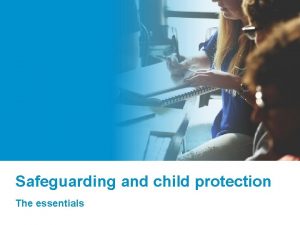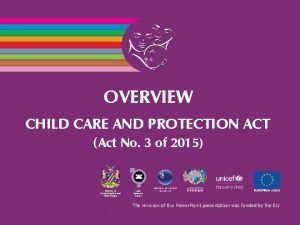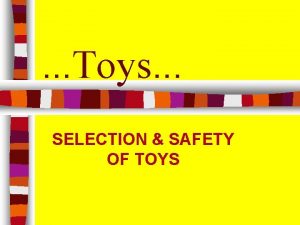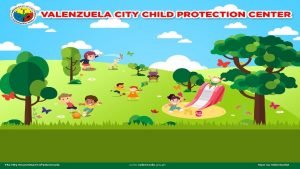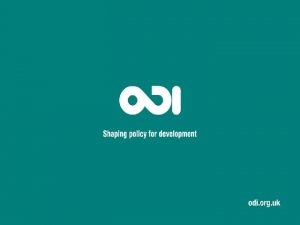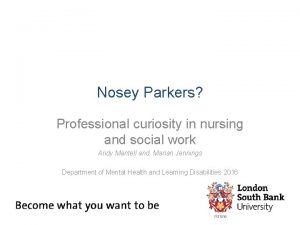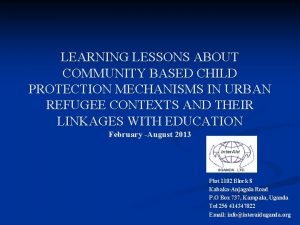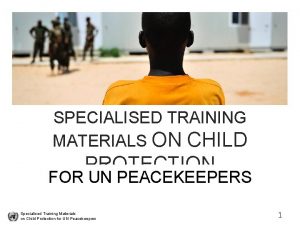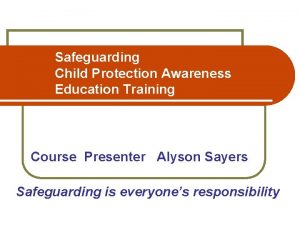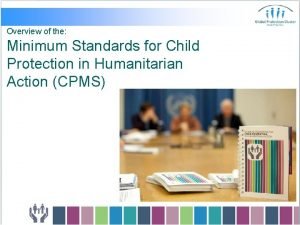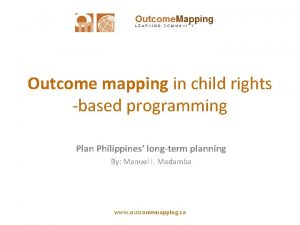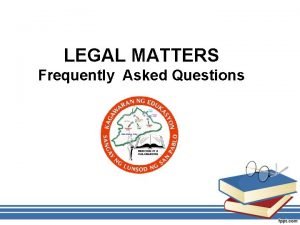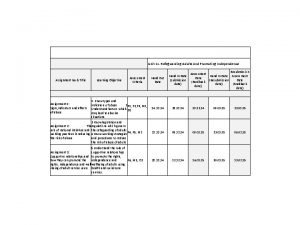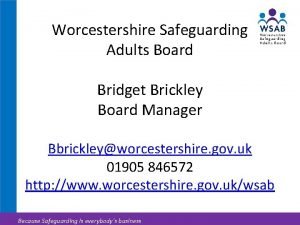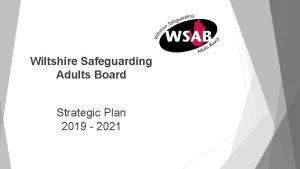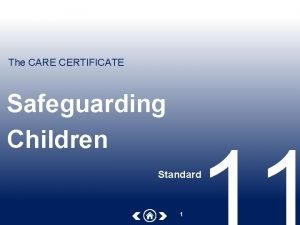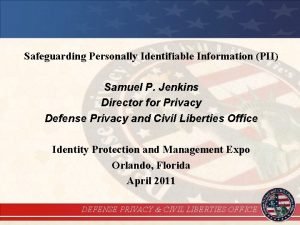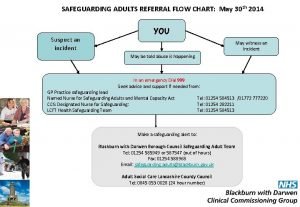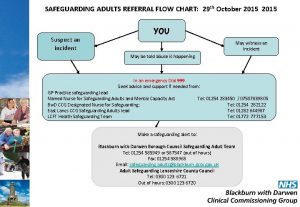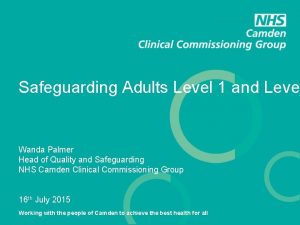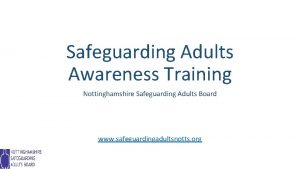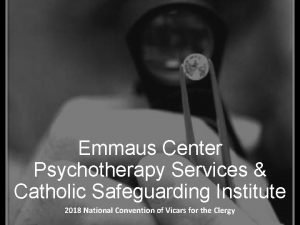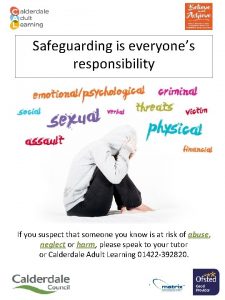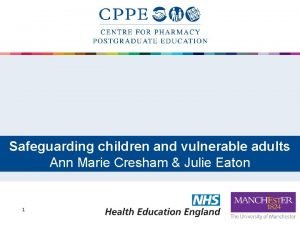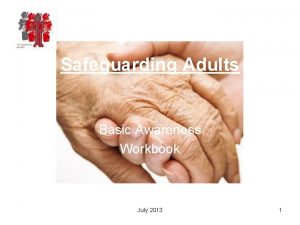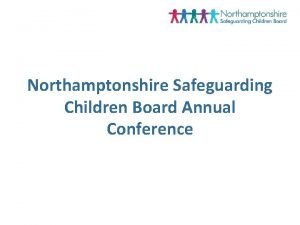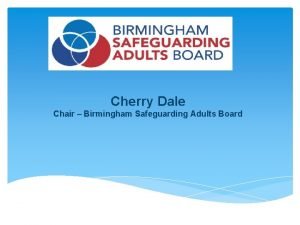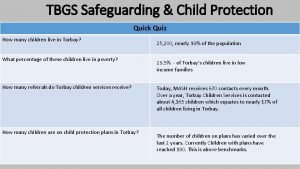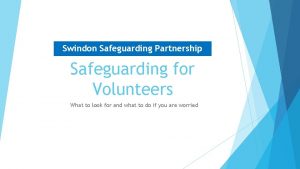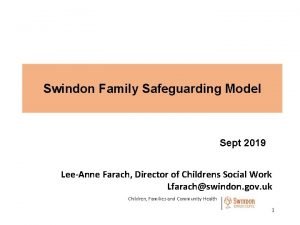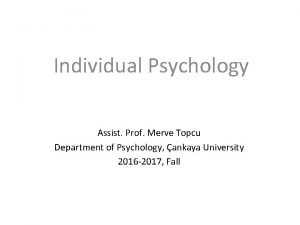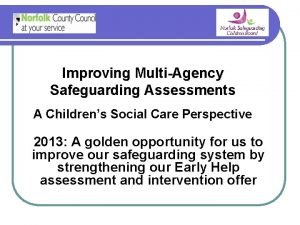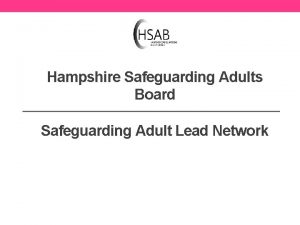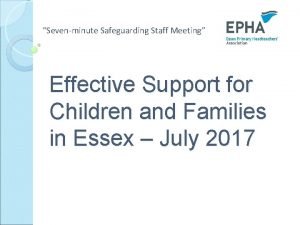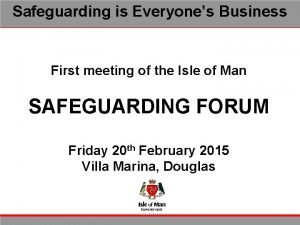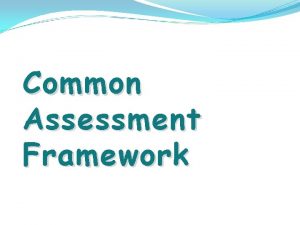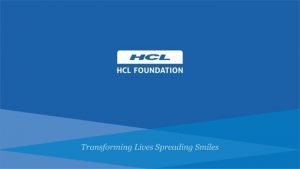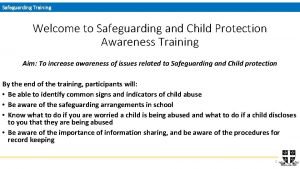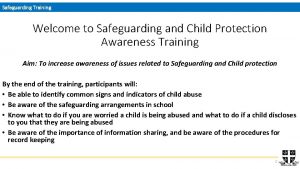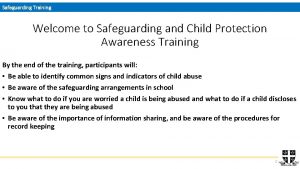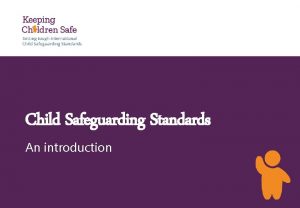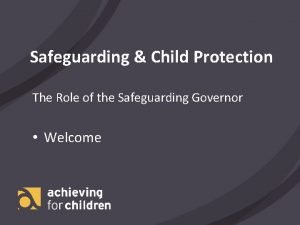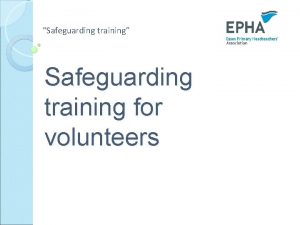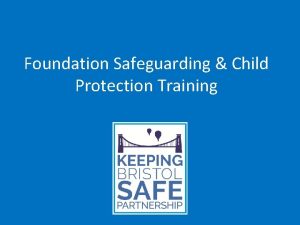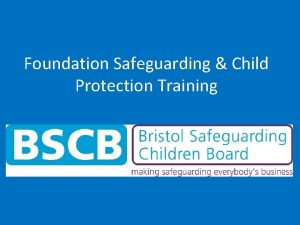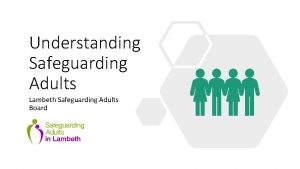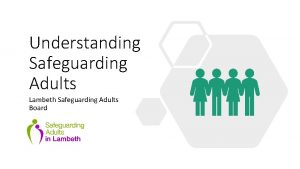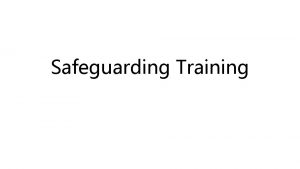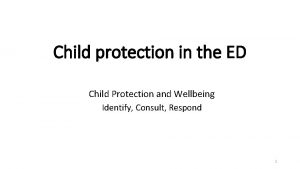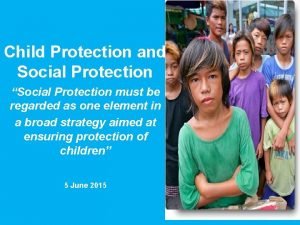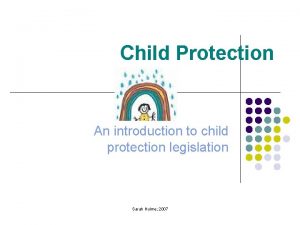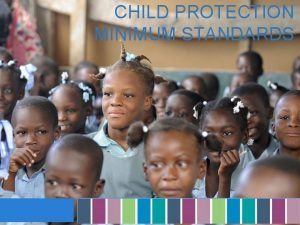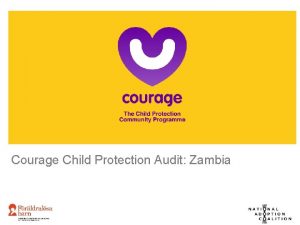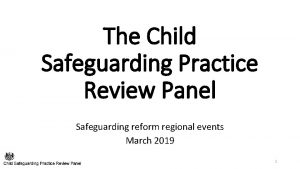What is safeguarding 1 Safeguarding and Child Protection













































- Slides: 45

What is safeguarding? 1

Safeguarding and Child Protection Safeguarding is more than child protection. Safeguarding begins with promotion and preventative activity which enables children and young people to grow up safely and securely in circumstances where their development and wellbeing is not adversely affected. It includes support to families and early intervention to meet the needs of children and continues through to child protection. Co- operating To Safeguard Children and Young People in Northern Ireland 2016

Anti-bullying Policy Child Protection Behaviour management Child Protection Policy Attendance, suspensions and expulsions & children missing education Transition arrangements SEN and inclusion Governance PDMU/ Curriculum Health and Safety E-safety CSE Risk assessment Whistle blowing lling e s n Cou ice v Ser Safe recruitment & selection. Staff code of conduct & safe practice Safeguarding Team The school environment buildings and security

Safeguarding Issues in Schools Neglect child sexual exploitation (CSE) female genital mutilation (FGM) teenage relationship abuse bullying including cyberbullying mental health drugs High risk behaviours Aggression Suicidal ideation Self-harm gangs and youth violence domestic violence forced marriage sexting gender-based violence/violence against women and girls (VAWG) alcohol abuse

UNCRC § Article 3 Right to have his/her welfare considered paramount in all decisions taken about him/her § Article 12 Right to be heard § Article 19 Right to be protected from abuse and neglect

Definitions and Signs and Symptoms of Abuse

Definition of Abuse Types of Abuse Harm can be suffered by a child or young person by acts of abuse perpetrated upon them by others. Abuse can happen in any family, but children may be more at risk if their parents have problems with drugs, alcohol and mental health, or if they live in a home where domestic abuse happens. Abuse can also occur outside of the family environment. Evidence shows that babies and children with disabilities can be more vulnerable to suffering abuse. Although the harm from the abuse might take a long time to be recognisable in the child or young person, professionals may be in a position to observe its indicators earlier, for example, in the way that a parent interacts with their child. Effective and ongoing information sharing is key between professionals.

Child In Need of Protection • A child in need of protection is a child who is at risk of, or likely to suffer, significant harm which can be attributed to a person or persons or organisation, either by an act of commission or omission; or a child who has suffered or is suffering significant harm as defined in Article 50 of the Children Order. Co-operating To Safeguard Children and Young People in Northern Ireland 2016

Types of Abuse • Physical • Sexual • Emotional • Neglect • Exploitation

Physical Abuse is deliberately hurting a child. It might take a variety of different forms, including hitting, biting, pinching, shaking, throwing, poisoning, burning or scalding, drowning or suffocating a child.

PHYSICAL ABUSE Physical Indicators Behavioural Indicators § Scratches § Bite marks or welts § Bruises in places difficult to mark (behind ears, groin) § Burns § Untreated injuries § Self mutilation tendencies § Chronic runaway § Aggressive or withdrawn § Fear of returning home § Undue fear of adults § Fearful watchfulness



Emotional Abuse is the persistent emotional maltreatment of a child. It is also sometimes called psychological abuse and it can have severe and persistent adverse effects on a child’s emotional development. Emotional abuse may involve deliberately telling a child that they are worthless, or unloved and inadequate. It may include not giving a child opportunities to express their views, deliberately silencing them, or ‘making fun’ of what they say or how they communicate. Emotional abuse may involve bullying – including online bullying through social networks, online games or mobile phones – by a child’s peers.

EMOTIONAL ABUSE Physical Indicators Behavioural Indicators § Sudden speech disorders§ Rocking, thumb sucking § Wetting and soiling § Fear of change § Signs of mutilation § Chronic runaway § Frequent vomiting § Poor peer relationships § Attention seeking behaviour

Sexual Abuse occurs when others use and exploit children sexually for their own gratification or gain or the gratification of others. Sexual abuse may involve physical contact, including assault by penetration (for example, rape, or oral sex) or non-penetrative acts such as masturbation, kissing, rubbing and touching outside clothing. It may include non-contact activities, such as involving children in the production of sexual images, forcing children to look at sexual images or watch sexual activities, encouraging children to behave in sexually inappropriate ways or grooming a child in preparation for abuse (including via e-technology). Sexual abuse is not solely perpetrated by adult males. Women can commit acts of sexual abuse, as can other children.

SEXUAL ABUSE Physical Indicators Behavioural Indicators § Chronic depression § Soreness, bleeding in genital or anal areas § Itching in genital areas § Inappropriate language, sexual knowledge for age group § Stained or bloody underwear § Making sexual advances to adults or other children § Stomach pains or headaches § Low self esteem § Pain on urination § Afraid of the dark § Difficulty in walking or sitting § Wariness of being approached by anyone § Bruises on inner thighs or buttocks § Evidence of substance misuse § Anorexic / bulimic § Acquisition of money, mobile phones etc without plausible explanation § Association with older people, particularly men, outside the usual range of contacts § Phone calls/messages from adults outside the normal range of contacts

Neglect is the failure to provide for a child’s basic needs, whether it be adequate food, clothing, hygiene, supervision or shelter that is likely to result in the serious impairment of a child’s health or development. Children who are neglected often also suffer from other types of abuse.

Neglect Physical Indicators Behavioural Indicators § Constant hunger § Exposed to danger; lack of supervision § Inadequate / inappropriate clothing § Poor hygiene § Untreated illnesses § Persistent tiredness § Listlessness § Lack of peer relationships § Low self-esteem § Compulsive stealing / begging

Exploitation is the intentional ill-treatment, manipulation or abuse of power and control over a child or young person; to take selfish or unfair advantage of a child or young person or situation, for personal gain. It may manifest itself in many forms such as child labour, slavery, servitude, engaging in criminal activity, begging, benefit or other financial fraud or child trafficking. It extends to the recruitment, transportation, transfer, harbouring or receipt of children for the purpose of exploitation. Exploitation can be sexual in nature.

Sexual exploitation of children and young people Child sexual exploitation is a form of sexual abuse where children are sexually exploited for money, power or status. It can involve violent, humiliating and degrading sexual assaults. In some cases, young people are persuaded or forced into exchanging sexual activity for money, drugs, gifts, affection or status.

Child sexual exploitation: is it happening in your school? CSE Helpline: 0800 389 1701 (NSPCC) 22

Sexual exploitation of children and young people Consent cannot be given, even where a child may believe they are voluntarily engaging in sexual activity with the person who is exploiting them. Child sexual exploitation doesn't always involve physical contact and can happen online. A significant number of children who are victims of sexual exploitation go missing from home, care and education at some point

Department of Education Tackling Child Sexual Exploitation in Northern Ireland Action Plan Supporting Recommendation 39 of the Marshall Report (Nov 2014) which stated : “Schools should ensure that all school governors have child protection awareness training which includes reference to CSE. The designated governor for child protection should have additional, enhanced training”.

DE Action Plan 2015 -2018 TACKLING CHILD SEXUAL EXPLOITATION IN Northern Ireland Engage parents in preventative education Guidance to schools on teaching issues re CSE Improve e-safety provision for parents, carers and education professionals CSE to be included in Initial Teacher Education Explore possibilities of peer education

Domestic Violence Domestic violence and abuse is: ‘Threatening, controlling, coercive behaviour, violence or abuse (psychological, virtual, physical, verbal, sexual, financial or emotional) inflicted on anyone (irrespective of age, ethnicity, religion, gender identity, sexual orientation or any form of disability) by a current or former intimate partner or family member. ’



FEMALE GENITAL MUTILATION

DE Tackling Child Sexual Exploitation - in Northern Ireland Action Plan Recommendation Progress 2016 S 3: In order to improve understanding and vigilance, schools should be alert to the possibility that young people who do not return after holidays abroad may have been subject to forced marriage. Any concerns should be reported to the designated teacher for child protection within the school for further escalation if appropriate. Status: Delivering Progress This issue is now included in the specialist training provided to Designated and Deputy Designated Teachers for Child Protection in schools. DE is drafting updated information and advice to schools in a new Guide to Child Protection in Schools which will include reference to the 2012 DFP Statutory Guidance on the Forced Marriage (Civil Protection) Act 2007.

MENTAL HEALTH EMOTIONAL Substance misuse Self harm Suicidal thoughts Eating disorders School refusal Body image Attachment disorder Gender identity Sexual identity

Self Harm And Suicide It is most helpful to consider self harm as a continuum, ranging from behaviour which has a strong suicidal intent (for example, some kinds of overdose) to behaviour which is intended to help the person stay alive (such as cutting)’ John Coleman 2004

Why do Young People Self-harm? • To release tension caused by anxiety, grief or anger. • As a means of communication, to tell themselves and others that they need help. • To feel as though they have control over something in their lives. • To make ‘real’ emotional pain they are unable to express.

E-Safety

DE GUIDANCE üCircular 2007/01 Technologies üCircular 2011/ 22 üCircular 2013/25 üCircular 2015/21 üCircular 2016/26 üCircular 2016/27 Devices Acceptable use of the Internet and Digital Internet Safety e-Safety Guidance Legal duties as Data Controllers Online Safety Effective Educational Uses of Mobile Digital § Management Responsibilities in Schools § Code of Safe Practice and Effective use § Education in Safe and Effective Practices § Digital Publishing and Software Licensing § Social Software § Management Information Systems § Child Protection (Bullying and Harrassment; Grooming and Child Abuse)

Recording of Child Protection Information Verbal report to DT especially in urgent matters • Note of concern completed and shared with DT. • Note of concern should be stored in the child’s Child Protection file along with all other records created and acquired as management of the concern progresses.

Safeguarding Awareness Raising for all school staff All staff need to know: • How to identify signs and symptoms of possible abuse • What the school procedures are • How to talk to children about whom there are concerns • Who are the Designated and Deputy Designated Teachers for child protection • Staff code of behaviour

School Safeguarding and Child Protection Policy § Every school must have one § Reviewed annually § Shared with parents § Talk to CPSSS for help

Emotional barriers and anxieties Anxiety often revolved around the following themes: § Worry about the reaction of the person they told § Worry that they would not be believed § Worry that they would be blamed § Worried that they would be labelled as a problematic child or adolescent § Worry that they were making a big deal out of what was going on § Worried about retaliation by the perpetrator(s) § Distrust in professionals and how they would respond No one listened, no one heard: a study of disclosures of childhood abuse. NSPCC 2013

Young people’s experience of disclosure in school Positive disclosure experiences occurred where: Negative disclosure experiences occurred where: § Young people were automatically believed § Teachers / staff failed to inform the young person of how they would handle the disclosureleaving the young person in suspense and fearful about what would happen next § Staff reported the abuse through appropriate channels § The staff member explained what would happen next and kept the child/YP informed § Emotional support through the process was provided by a teacher § Some teachers went straight to the parents who were the perpetrators of abuse or who were aware of/or enabled the abuse in some way

A child-centred approach. Children have said that they need: § Vigilence: to have adults notice when things are troubling them § Understanding and action: to understand what is happening; to be heard and understood; and to have that understanding acted upon § Stability: to be able to develop an on-going relationship of trust with those helping them § Respect: to be treated with the expectation that they are competent rather than not § Information and engagement: to be informed about and involved in procedures, decisions, concerns and plans § Explanation: to be informed of the outcome of assessments and decisions and reasons when their views have not met with a positvie response § Support: to be provided with support in their own right as well as a member of their family § Advocacy: to be provided with advocacy to assist then in putting forward their views

Dealing with Disclosures in school – all staff Receive Listen actively, open body language, accept, non judgemental TED (tell, explain, describe) Reassure ‘You’ve done the right thing by coming to me’, re-assure child that you have listened and hear what they are saying; don’t promise what can’t be delivered Respond Tell what you are going to do and do it. Ensure child is ok before leaving Report As soon as possible, to the DT Record Vital – facts, no opinions – When? Where? Who? What?


What all staff need to know • All staff who work in the school during the hours in which pupils are on the premises, including ancillary staff, and any volunteers accepted to work in the school, need to know: • how to identify the signs and symptoms of possible abuse; • what the relevant child protection procedures are, including the school’s own internal procedures, where they are held in the school and how they can be referred to if necessary; • what the reporting procedures are; • how to talk to children about whom there are concerns in an appropriate way, and how to record the information they have acquired; and • who the designated teacher is and who will carry out his/her responsibilities if he/she is unavailable or is the subject of the complaint. • All such members of staff should be aware of the roles played by the designated teacher, the Principal and the Chairperson of the Board of Governors respectively

Note of concern • Any member of staff who has a concern about the welfare or safety of a child or young person should complete a Note of Concern (see Appendix 1). Notes must be made as soon as possible after the incident to ensure an expedient response, and certainly within 24 hours, to maintain the accuracy and content of the report. For some children a one-off serious incident or concern may occur and staff will have no doubt that this must be immediately recorded and reported. More often, however, it is the accumulation of a number of small incidents, events or observations that can provide the evidence of harm being caused to a child.
 Safeguarding and child protection the essentials
Safeguarding and child protection the essentials Child safeguarding standards
Child safeguarding standards Rights and responsibilities of a child at school
Rights and responsibilities of a child at school Child protection and toy safety act
Child protection and toy safety act Child care and protection act 3 of 2015
Child care and protection act 3 of 2015 Courage child protection
Courage child protection Types of child protection
Types of child protection Types of child protection
Types of child protection Child protection case management tools
Child protection case management tools Types of child protection
Types of child protection Professional curiosity in child protection
Professional curiosity in child protection Community based child protection mechanisms
Community based child protection mechanisms Child protection training materials
Child protection training materials Child protection awareness training
Child protection awareness training Child protection minimum standards
Child protection minimum standards Child protection policy
Child protection policy 2 disinterested person
2 disinterested person Child protection reform amendment act 2017
Child protection reform amendment act 2017 전위 순회
전위 순회 Unit 11 safeguarding adults and promoting independence
Unit 11 safeguarding adults and promoting independence Worcestershire safeguarding board
Worcestershire safeguarding board Wiltshire safeguarding training
Wiltshire safeguarding training Safeguarding children care certificate
Safeguarding children care certificate Safeguarding pii
Safeguarding pii Safeguarding referral flowchart
Safeguarding referral flowchart National referral mechanism-flowchart
National referral mechanism-flowchart 6 principles of safeguarding
6 principles of safeguarding 6 principles of safeguarding
6 principles of safeguarding What is pan london safeguarding
What is pan london safeguarding Catholic safeguarding institute
Catholic safeguarding institute Safeguarding pro andrew hall
Safeguarding pro andrew hall Safeguarding is everyone's responsibility
Safeguarding is everyone's responsibility Cppe safeguarding
Cppe safeguarding Family safeguarding workbook
Family safeguarding workbook Portsmouth safeguarding
Portsmouth safeguarding Northamptonshire safeguarding
Northamptonshire safeguarding Birmingham safeguarding board
Birmingham safeguarding board Keeping children safe
Keeping children safe Swindon safeguarding partnership
Swindon safeguarding partnership Lee-anne farach
Lee-anne farach Abnormal development adler
Abnormal development adler Kirklees safeguarding childrens board
Kirklees safeguarding childrens board Safeguarding adults hampshire
Safeguarding adults hampshire 7 minute safeguarding briefings essex
7 minute safeguarding briefings essex Safeguarding is everyone's business
Safeguarding is everyone's business Caf pre assessment checklist
Caf pre assessment checklist
